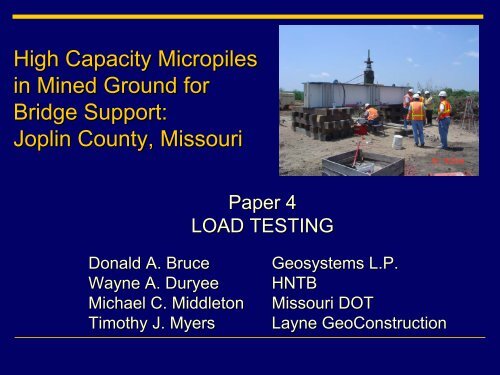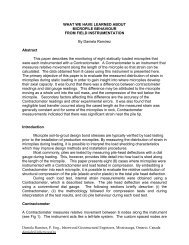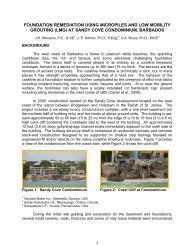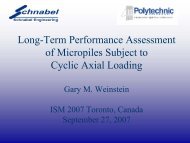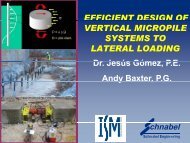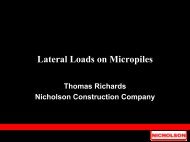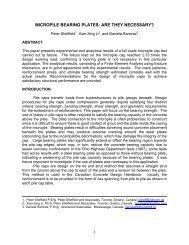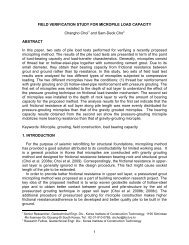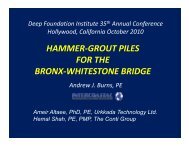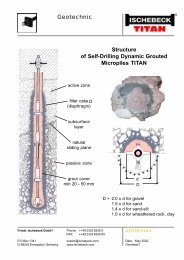Load Testing of Production Piles, Dr. Donald Bruce, Geosystems ...
Load Testing of Production Piles, Dr. Donald Bruce, Geosystems ...
Load Testing of Production Piles, Dr. Donald Bruce, Geosystems ...
You also want an ePaper? Increase the reach of your titles
YUMPU automatically turns print PDFs into web optimized ePapers that Google loves.
High Capacity Micropiles<br />
in Mined Ground for<br />
Bridge Support:<br />
Joplin County, Missouri<br />
Paper 4<br />
LOAD TESTING<br />
<strong>Donald</strong> A. <strong>Bruce</strong><br />
Wayne A. Duryee<br />
Michael C. Middleton<br />
Timothy J. Myers<br />
<strong>Geosystems</strong> L.P.<br />
HNTB<br />
Missouri DOT<br />
Layne GeoConstruction
Scope<br />
1. Introduction<br />
2. Technical Requirements<br />
2.1 Specifications<br />
2.2.1 Verification <strong>Load</strong> Tests<br />
2.1.2 Pro<strong>of</strong> Tests<br />
2.2 Contractor’s Conforming Submittal<br />
3. Results <strong>of</strong> Verification Tests (4) - (Paper 2: Foster,<br />
Peters, <strong>Bruce</strong>, Chuaqui and Norrish)<br />
4. Results <strong>of</strong> the Pro<strong>of</strong> Tests (16)<br />
5. Final Observations
2. Technical Requirements<br />
2.1 Specifications<br />
– Minimum anticipated cased and bond zone<br />
lengths provided per pile.<br />
– Minimum load requirements provided per pile.<br />
– GBR bond values to be verified by 4<br />
preproduction Verification piles, and directed<br />
thereafter by the Engineer.<br />
– Contractor to design and conduct load tests and<br />
collect all load/movement data.<br />
– Pro<strong>of</strong> testing <strong>of</strong> production piles: one per each <strong>of</strong><br />
the 16 bents to 1.2 DL.
2.1.1 Verification <strong>Load</strong> Tests: Summary<br />
– 4 vertical piles in different ground conditions.<br />
– Test cyclically to 2.0 DL.<br />
– Conduct creep tests.<br />
– No acceptance criteria, i.e., no pass-fail.
Actual Verification Pile Dimensions and Ground Conditions
Details <strong>of</strong> Verification Pile <strong>Testing</strong>
2.1.2 Pro<strong>of</strong> Tests<br />
– Total <strong>of</strong> 220 production piles (vertical and inclined).<br />
– 16 Pro<strong>of</strong> Tests – locations at each bent to be selected in<br />
the field by the Engineer.<br />
– Simple incremental tensile loading to 1.2 DL, with 60-<br />
minute creep test (Modified ASTM D3689 Quick Test).<br />
– Acceptance criteria:<br />
1. No failure at TL.<br />
2. Debonding at TL ≤ 50% bond length.<br />
3. Creep rate ≤ 1 mm per log cycle (1-10 10 mins.) or ≤ 2mm<br />
per log cycle (6-60 60 mins.).<br />
– If failure occurs, test another pile in the same bent, and<br />
consider modifications, down rating, replacement, etc.<br />
– Each test paid for on lump-sum basis.
2.2 Contractor’s Conforming Submittal
Tension Test Setup
<strong>Load</strong> <strong>Testing</strong> in Progress
4. Results <strong>of</strong> the Pro<strong>of</strong> Tests<br />
– Every micropile reached the test loads (986-2,269<br />
kN).<br />
– At TL debonded lengths were exceptionally small<br />
and in only one case did it extend beyond the<br />
cased length.<br />
– Permanent movements at TL ranged from 0.34 to<br />
6.45 mm (typically < 3 mm).<br />
– All load-movement curves were very linear.<br />
– Every pile comfortably satisfied the creep criteria.<br />
– Paper contains full details (Table 7).
5. Final Observations<br />
– The “chaotic” ground had the potential to:<br />
• render design very challenging;<br />
• cause difficulties and dangers during construction;<br />
• cause performance problems during service.<br />
– An intensive site investigation, relying also on historical data,<br />
permitted a bent-specific GBR to be prepared.<br />
– The GBR drove the concept and details <strong>of</strong> pretreatment by<br />
grouting as an exploratory tool<br />
as well as a ground remediation/<br />
preparation in advance <strong>of</strong><br />
micropiling or spread footing<br />
construction.
5. Final Observations (continued)<br />
– The Verification <strong>Piles</strong> allowed the preliminary design <strong>of</strong><br />
bond lengths to be confirmed/modified.<br />
– During construction, no exceptional problems were<br />
encountered, and the pretreatment was monitored and<br />
directed in real time.<br />
– All Pro<strong>of</strong> Tests were successful and no remedial piles<br />
were required.<br />
– The field program was implemented within an acceptable<br />
schedule and with only minor changes/ overruns.<br />
– The keys to success were technical risk management at<br />
every phase <strong>of</strong> the project, and efficient collaboration<br />
between a team <strong>of</strong> specialists <strong>of</strong> different but<br />
complimentary skills and experiences.


